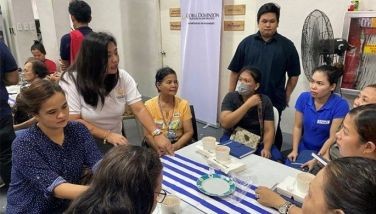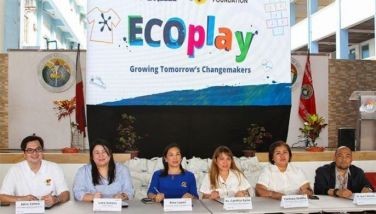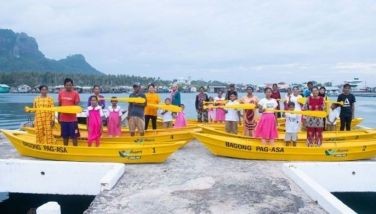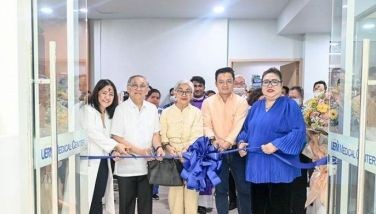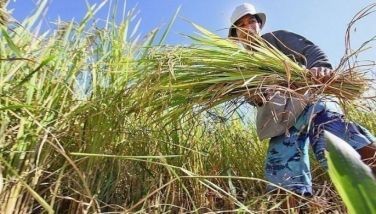Pushing the frontiers of economic development
August 6, 2006 | 12:00am
Research continues to push farther the frontiers of development in the country.
Encouragingly, too, government research and development (R&D) institutions are now implementing programs to commercialize "mature technologies," or those innovations that have been assessed to be ready for adoption by farmers, entrepreneurs and other interested entities and individuals.
This is best exemplified by the Technology Commercialization Program (TCP) now being undertaken by the Department of Agriculture (DA) through its Bureau of Agricultural Research (BAR).
The TCP disseminates usable information for prospective investors to venture into agricultural enterprises. This is done through the conduct of fora where the technology generators, farmers and fisherfolks are given the opportunity to discuss the advantages, issues and concerns regarding the technologies presented.
In 2005-2006, for instance, BAR coordinated eight ongoing technology commercialization projects. These technologies were sourced through conferences and field visitations participated in by concerned BAR staff members.
Other sources are results of research projects funded by BAR, mostly state colleges and universities (SCUs) across the country.
For the period under review, BAR funded 99 research projects out of 333 proposals submitted to the bureau for funding. These covered priority commodities such as rice, corn, high-value crops, livestock and fisheries.
Agriculture Secretary Domingo F. Panganiban himself is spearheading the technology commercialization program, saying it is DA’s way of enabling the people, particularly farmers and fisherfolk, to benefit from the fruits of research.
Since TCP’s implementation, three technology commercialization fora which showcased 23 technologies have been conducted. To sustain this activity, BAR conducts continuing activity of technology sourcing through which 29 mature technologies have been identified for dissemination.
An encouraging dimension of the government’s R&D thrust in agriculture is the direct involvement of farmers and fisherfolk in the research activities.
This is best exemplified by BAR’s Community Participatory Action Research (CPAR) program, whose implementation across the country has also been a priority of DA under Panganiban.
For about half a decade now, BAR, which marks its 19th anniversary on Aug. 7-8, has been implementing CPAR as its banner program in technology dissemination and utilization. It involves farmers and fisherfolk in the research who are allowed to participate in decision-making for the refinement of packages of technologies used to suit the specific needs of the farming community.
CPAR’s on-farm researches are conducted by DA’s Regional Integrated Agricultural Research Centers (RIARC).
"CPAR’s objectives," BAR Director Nicomedes P. Eleazar said, "is to verify the technical and economic viability of cost-effective and site-specific technologies and transfer them to the farming and fishing communities to increase total farm productivity and income within the context of a sustainable productive system."
Since CPAR’s intensification in 2002, projects have been conducted in 151 sites, involving 1,471 farmer-cooperators.
BAR has also been implementing a human resource development (HRD) program for scientists, researchers and technical staff members in keeping with its objective of promoting excellence in the DA-BAR-coordinated National Research and Development System for Agriculture and Fisheries (NaRDSAF).
The HRD program enables research staff members to pursue higher studies (doctoral of PhD and master’s or MS) by way of giving financial support.
Since the graduate study program was launched in 2000, it had already produced 50 graduates (26 PhD and 24 MS).
Eleazar also reported that BAR continues to implement its Institutional Development Grant (IDG) program to provide a conducive environment for the efficient conduct of research as part of the holistic approach to strengthen the NaRDSAF.
IDG is a flexible facility for the acquisition of scientific equipment, renovation and construction of research facilities, preparation of master station development plan and other critical needs of the R&D centers.
Encouragingly, too, government research and development (R&D) institutions are now implementing programs to commercialize "mature technologies," or those innovations that have been assessed to be ready for adoption by farmers, entrepreneurs and other interested entities and individuals.
This is best exemplified by the Technology Commercialization Program (TCP) now being undertaken by the Department of Agriculture (DA) through its Bureau of Agricultural Research (BAR).
The TCP disseminates usable information for prospective investors to venture into agricultural enterprises. This is done through the conduct of fora where the technology generators, farmers and fisherfolks are given the opportunity to discuss the advantages, issues and concerns regarding the technologies presented.
In 2005-2006, for instance, BAR coordinated eight ongoing technology commercialization projects. These technologies were sourced through conferences and field visitations participated in by concerned BAR staff members.
Other sources are results of research projects funded by BAR, mostly state colleges and universities (SCUs) across the country.
For the period under review, BAR funded 99 research projects out of 333 proposals submitted to the bureau for funding. These covered priority commodities such as rice, corn, high-value crops, livestock and fisheries.
Agriculture Secretary Domingo F. Panganiban himself is spearheading the technology commercialization program, saying it is DA’s way of enabling the people, particularly farmers and fisherfolk, to benefit from the fruits of research.
Since TCP’s implementation, three technology commercialization fora which showcased 23 technologies have been conducted. To sustain this activity, BAR conducts continuing activity of technology sourcing through which 29 mature technologies have been identified for dissemination.
An encouraging dimension of the government’s R&D thrust in agriculture is the direct involvement of farmers and fisherfolk in the research activities.
This is best exemplified by BAR’s Community Participatory Action Research (CPAR) program, whose implementation across the country has also been a priority of DA under Panganiban.
For about half a decade now, BAR, which marks its 19th anniversary on Aug. 7-8, has been implementing CPAR as its banner program in technology dissemination and utilization. It involves farmers and fisherfolk in the research who are allowed to participate in decision-making for the refinement of packages of technologies used to suit the specific needs of the farming community.
CPAR’s on-farm researches are conducted by DA’s Regional Integrated Agricultural Research Centers (RIARC).
"CPAR’s objectives," BAR Director Nicomedes P. Eleazar said, "is to verify the technical and economic viability of cost-effective and site-specific technologies and transfer them to the farming and fishing communities to increase total farm productivity and income within the context of a sustainable productive system."
Since CPAR’s intensification in 2002, projects have been conducted in 151 sites, involving 1,471 farmer-cooperators.
BAR has also been implementing a human resource development (HRD) program for scientists, researchers and technical staff members in keeping with its objective of promoting excellence in the DA-BAR-coordinated National Research and Development System for Agriculture and Fisheries (NaRDSAF).
The HRD program enables research staff members to pursue higher studies (doctoral of PhD and master’s or MS) by way of giving financial support.
Since the graduate study program was launched in 2000, it had already produced 50 graduates (26 PhD and 24 MS).
Eleazar also reported that BAR continues to implement its Institutional Development Grant (IDG) program to provide a conducive environment for the efficient conduct of research as part of the holistic approach to strengthen the NaRDSAF.
IDG is a flexible facility for the acquisition of scientific equipment, renovation and construction of research facilities, preparation of master station development plan and other critical needs of the R&D centers.
BrandSpace Articles
<
>
- Latest
Latest
Latest
November 9, 2024 - 3:43pm
By E.H. Edejer | November 9, 2024 - 3:43pm
June 9, 2024 - 5:55pm
By Alberto Peña | June 9, 2024 - 5:55pm
May 24, 2024 - 10:00am
May 24, 2024 - 10:00am
May 14, 2024 - 3:43pm
By Ian Laqui | May 14, 2024 - 3:43pm
April 10, 2024 - 5:12pm
By Ian Laqui | April 10, 2024 - 5:12pm
Recommended










